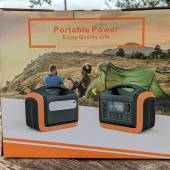The Lowdown
Whether you are planning a weekend at a remote site or you’re just trying to make sure that you’ll have enough power to keep your essentials going while the electricity is out, the 1100W OUPES Portable Power Station is a solid choice.
Overall
Pros
- Portable design with an integrated handle
- You can use this power station to charge up to 10 devices simultaneously
- Recharges from empty in as little as 7.5 hours
- Compatible with just about all essential devices including your laptop, mobile phone, and any AC powered device that pulls less than 1100W
- Perfect for camping and for powering your essentials during electricity outages at home
- Can be recharged via the optional solar panels
- Silent while charging or powering USB devices, but there is a fan that will kick on when a higher-draw item is plugged-in
- Built-in LED light
- Easy to understand display
- UPS power for essential plugged-in devices
- BMS provides over-voltage protection, over-current protection, and over-heat protection and adjusts the charging voltage and speed for your particular device’s charging needs
Cons
- The user manual contains only very basic information
We’d all like to think that when severe weather hits, we’ll be prepared. We’ll have food, water, and candles ready and waiting with enough notice. But if there isn’t a plan in place for providing emergency power during sustained blackouts, there’s still an important issue that needs to be addressed. Planning ahead and getting a 1100W OUPES Portable Power Station will give you peace of mind; when the power goes out, you’ll be able to keep your essential devices powered. It’s also handy for camping and other off-grid outdoor activities.

It’s easy to get complacent about all of the conveniences electricity affords us: We flick a switch, and we expect the light to come on. When we turn on a faucet, we expect water to come out; when we plug in an item, we expect it to be powered. If we adjust the thermostat, we expect to be kept at a comfortable temperature. But bad weather can quickly send our modern conveniences back into the stone age.
Having a significant power source ready to keep your necessary electronics, small appliances, and home medical devices running when the power goes out is not just good planning. It can make a difference in whether you can stay comfortable during a prolonged blackout, or if you are shut off from communication, or much worse. The 1100W OUPES Portable Power Station is an excellent option for anyone who doesn’t have the desire or the necessary outdoor space to run a gas-powered generator.
As I pointed out when I reviewed the slightly smaller Anker Powerhouse II 800 earlier this year, there are significant differences between a power station like this and a gas-powered generator. Gas-powered generators release poisonous carbon monoxide (CO), and you should never run them from inside an enclosed space like a garage or home.
The 1100W OUPES Portable Power Station is basically an extra-large battery pack; it does not have a combustible engine that generates the output power. Therefore, it can safely be stored and used inside a house, vehicle, or tent.
The power station features a 310,000mAh Lithium (Li) Iron (Fe) Phosphate (PO) (LiFePO4) battery that provides 992Wh of power.
It can run a 110W 43″ TV for 7.9 hours, a 10W light for 87 hours, a 30W fan for 29 hours, a 10W router for 87 hours, a 50W mini fridge for 17.5 hours, and a 400W space heater for 2 hours. It can also charge a 13″ MacBook Pro eight times, a smartphone with a 5,000mAh battery 62 times, a tablet with an 8,000mAh battery 38 times, and a 51Wh drone 17 times.
It’s worth noting that LiFePO4 batteries are safe and stable; they will not catch fire or explode. LiFePO4 batteries do not contain cobalt or other heavy metals, making them more environmentally friendly. This battery is rated for over 3600 charging cycles, has a fire rating of UL94-V0, and can work at temperatures ranging from 14º to 149ºF (-10 to 65ºC).
Bear in mind that the 1100W OUPES Portable Power Station won’t power anything that draws over 1100W of power. For instance, it won’t be able to power a hairdryer (typically 1200-1800 watts), a large microwave (typically 1200-1500 watts), a larger space heater (typically 1500W), or an electric car (typically 7200 watts or a little less).
Let’s take a look at the 1100W OUPES Portable Power Station
The box includes the portable power station, a wall charger, a DC car charger, a very minimal four-page user manual, and warranty information.
The 1100W OUPES Portable Power Station measures approximately 13″ wide by 11″ tall by 9″ deep; it weighs about 30 pounds. The build quality is excellent with its two-tone, hard black plastic body with an orange, rounded rubber bumper design.
According to the user manual, this power station has a rated working temperature of 32º to 113º, and it has an IP21 resistance rating which means it offers protection against solid objects over 12mm (like fingers) and protection from vertically falling drops of water (like condensation).
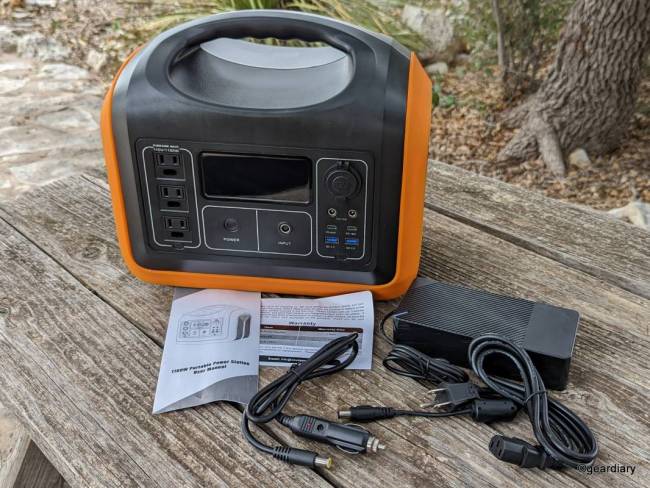
The Power Station’s integrated handle is thick and comfortable to hold, making it easy enough to pick up for moving from room to room. It’s also handy to bring along on car trips, camping, or taking to and from an off-grid hunting blind or ice fishing shack.
On the front left, there are three pure sine wave 110V/60Hz AC outlets rated for 1100W with 3600W surge power; under them, there is a button that turns those specific outlets on or off.
Under the 4″ wide by 2″ tall LCD, there is a power button next to an input port for the included wall charger or car charger. You can also use the same to get power from up to two of the optional 100W solar panels that OUPES sells for $249 each. The power button is more for activating the display than for powering anything plugged into the outlets or ports, as each of those sections has its own power button.
On the upper right, there is a 12V DC car outlet followed by two 12V DC 5521 outputs, two PD USB Type-C ports (the left port is 60W and the right port is 18W), two Qualcomm Quick Charge 3.0 USB Type-A ports; at the bottom, there is a button that will turn these specific ports on or off.

A simple thing to remember is that when using the power station to charge something, you’ll need to hit the power button under the corresponding outlet or port where you have things plugged in. Likewise, when you unplug something from one of the outlets or ports, you’ll need to turn off the corresponding power button under the port.
In theory, the 1100W OUPES Portable Power Station can power up to ten devices at once. Realistically, adding too many items at once will significantly cut down on its runtime before it needs a recharge. Treat it as an emergency power source for your most important devices, like a mobile phone, laptop, or a single small electrical appliance, and you’ll get the most extended runtime possible.
The LCD has an easy-to-read and understandable layout. There is an hours display on the left of the LCD, which tells you roughly how much time you have left under the current load; it will also tell you how much time is left to a complete charge when you’re recharging it with nothing else plugged in.
It makes sense that the more things you plug into the power station, the more quickly your remaining time shown will drop; likewise, if you remove plugged-in items or as they fully charge, you’ll see the remaining hours shown growing. It’s a handy, clear representation of what you can realistically expect.
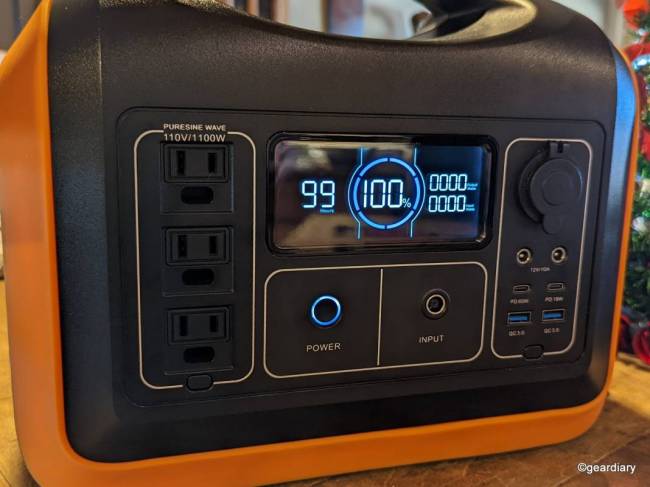
The 1100W OUPES Portable Power Station is shown fully charged and with no power being drawn.
In the center of the display, a circular graphic of the remaining battery capacity is broken into six segments that will disappear as the battery capacity dwindles or reappears during charging as the power is replenished. Even better, there is an actual battery capacity percentage in the center of the circle, so you don’t have to try to figure out how much power is left.
On the upper right of the LCD, there is a numeric output power watts display; below it is an input power watts display.
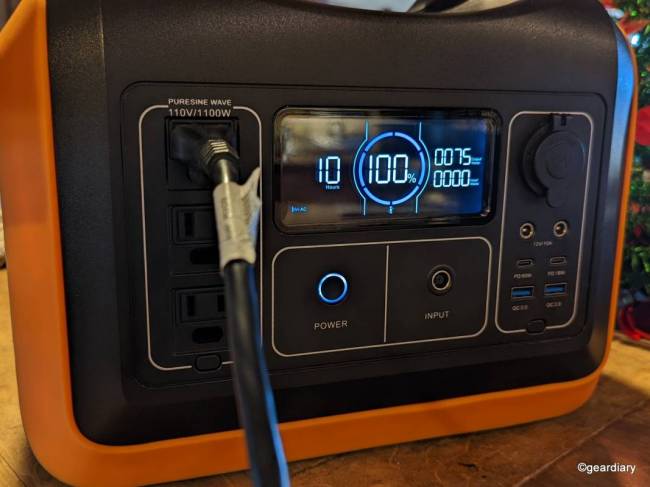
The 1100W OUPES Portable Power Station is shown powering the Lenovo ThinkPad X1 Extreme Gen 4. The remaining hour’s readout will fluctuate as the items being powered charge, showing lower when the devices drawing power are charging and higher when they are charged and no longer drawing power.
Not lit up on the display until they are needed or being used are a fault warning indicator, an AC power indicator, a USB Type-A indicator, a USB Type-C indicator, an over-temperature warning light, a cooling fan indicator, a low-temperature indicator, a DC car charge indicator, and a DC indicator.
When the 1100W OUPES Portable Power Station is powering something with a higher draw, like my 16″ Lenovo laptop, you can hear a soft fan whirring, but it is a tranquil, white noise-like whirring sound that shouldn’t interfere with sleep. Depending upon the environment where the power station is being used, you might not even hear the fan. The power station is silent when powering devices via USB Type-C or Type-A.
There is an airflow vent on the left side of the portable power station.
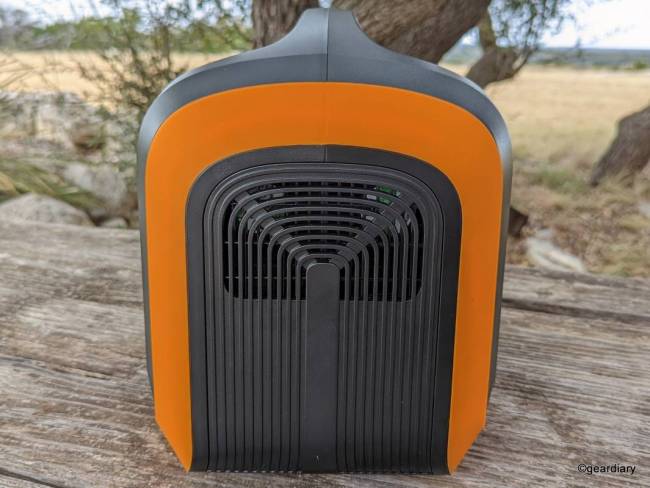
On the back, there is a 9″ long by 2.25″ tall 5W three-mode LED light that, when pressed, cycles between half-brightness, full brightness, SOS in Morse code, and off. This built-in light will be pretty handy in a blackout or when camping, as it is one less thing to worry about (or have to bring), and it draws such low power.
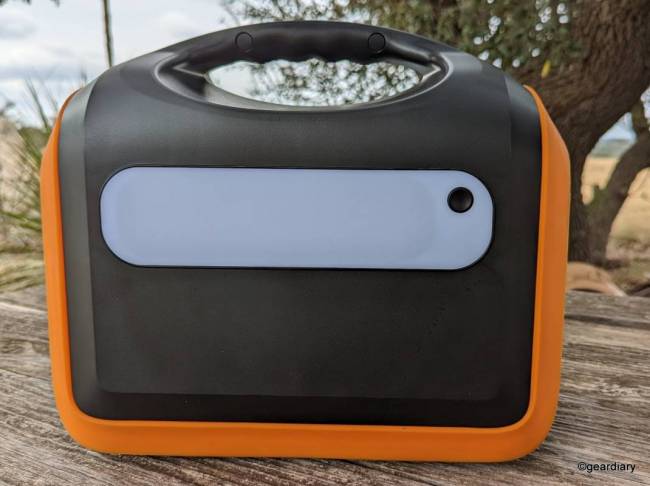
On the right, there is another airflow vent.
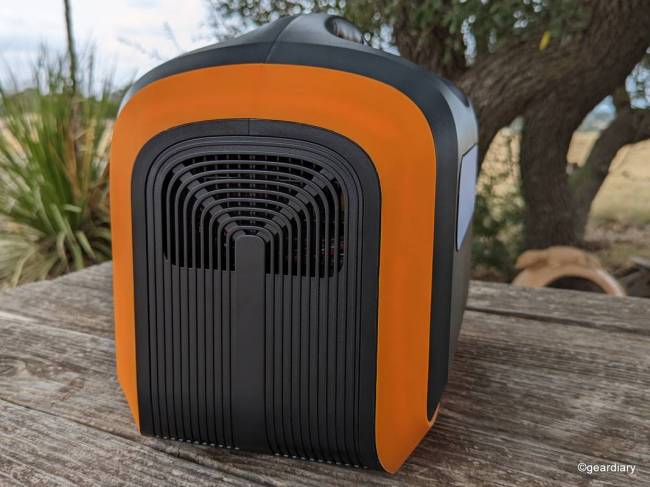
There are four L-shaped rubber feet on the bottom, which will keep it seated firmly on the surface where it’s placed without worrying that it might scratch a table or more delicate floor surfaces

1100W OUPES Portable Power Station Battery Life
The 100W OUPES Portable Power Station arrived with a 52% charge out of the box. I began charging it at 3:20 pm; as you can see here, it had a 52% charge out of the box. At 6:15 pm, the power station was fully charged, which correlates perfectly with the hours showing as remaining on display.
If you are fully recharging the power station from a wall outlet, it should take about 7.5 hours. When using the included 12V car/boat adapter, a full charge will take about 8 to 12 hours, and recharging it from two optional solar panels (with a Y parallel cable through the power port) will take 6 to 8 hours on a warm sunny day.
For obvious reasons, temperature, weather, and the environment can affect the solar panels’ charging time. The solar panels won’t be effective if the day is entirely overcast or the light intensity is poor.
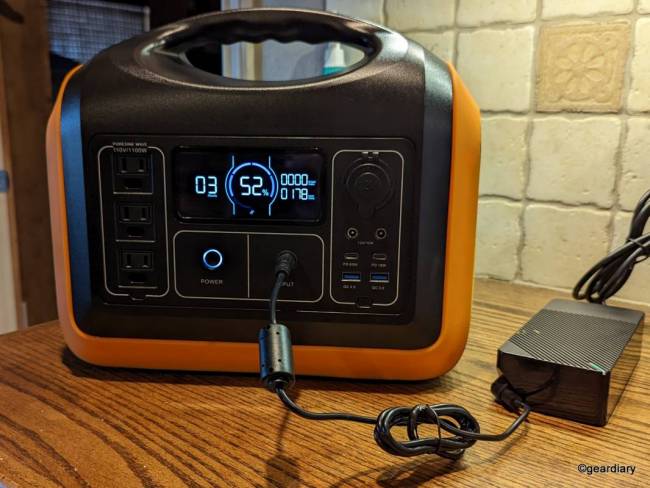
The power station has a battery management system (BMS ) that provides over-voltage, over-current, and over-heat protection. The BMS will adjust the charging voltage and speed for your particular device’s charging needs, so that’s one less thing to worry about for any delicate electronics.
The 1100W OUPES Portable Power Station can be plugged in and kept fully charged anywhere in your home or garage where there’s an empty outlet; it will act as an uninterruptible power supply (UPS) to anything you keep plugged in. If the power shuts off, the power station will continue to charge or power the plugged-in item until the battery capacity is depleted.
Suppose you have a medical device like a CPAP or a home ventilator that you absolutely can’t allow to lose power in the middle of the night, which seems to be when most blackouts occur. In that case, you could use the power station as a UPS, and it would continue powering your medical device until the power station’s battery runs out or the power comes on, whichever occurs first.
Powering an essential medical device in a blackout brings up an important point. Last February, Texas got slammed with one massive winter storm after another; millions of Texans, including us, lost power for days. As many as 700 people died by some counts — not only because they didn’t have heat or running water, but because they couldn’t power their essential medical devices.
The typical CPAP machine draws between 30 – 60 watts, which means that the 1100W OUPES Portable Power Station could power one for 14.5 to 29 additional hours, depending upon the CPAP’s wattage. A home ventilator typically draws around 300W, which means the OUPES could power one for an extra 2.9 hours.
You can figure out how long the OUPES Portable Power Station could power your medical device using this formula:
992Wh x 0.88 ÷ [the watts your particular device uses] = [the number of hours the portable power station uses can keep your device running].
While an extra 2.9 hours of power might not seem like much — in the ventilator’s case, at least— it could mean the difference of a loved one being without their oxygen or being able to get to a shelter in an extended blackout without issues. Unless you truly live in the middle of nowhere, those three extra hours could make a huge difference!
Campers, hunters, anglers, and other outdoorsy folks will appreciate the portability and versatility that the 1100W OUPES Portable Power Station offers; they can go completely off-grid and still enjoy some of the modern conveniences that they enjoy at home. When the trip is over, they can bring the power station home for a recharge, and it will be handy when the next power outage occurs — as one inevitably will.
Whether you are planning a weekend at a remote site or you’re just trying to make sure that you’ll have enough power to keep your essentials going while the electricity is out, the 1100W OUPES Portable Power Station is a solid choice.
The 1100W OUPES Portable Power Station retails for $999.99; it is available directly from the manufacturer and Amazon.
Source: Manufacturer supplied review sample
What I Like: Portable design with an integrated handle; You can use this power station to charge up to 10 devices simultaneously; Recharges from empty in as little as 7.5 hours; Compatible with just about all essential devices including your laptop, mobile phone, and any AC powered device that pulls less than 1100W; Perfect for camping and for powering your essentials during electricity outages at home; Can be recharged via the optional solar panels; Silent while charging or powering USB devices, but there is a fan that will kick on when a higher-draw item is plugged-in; Built-in LED light; Easy to understand display; UPS power for essential plugged-in devices; BMS provides over-voltage protection, over-current protection, and over-heat protection and adjusts the charging voltage and speed for your particular device’s charging needs
What Needs Improvement: The user manual contains only very basic information

